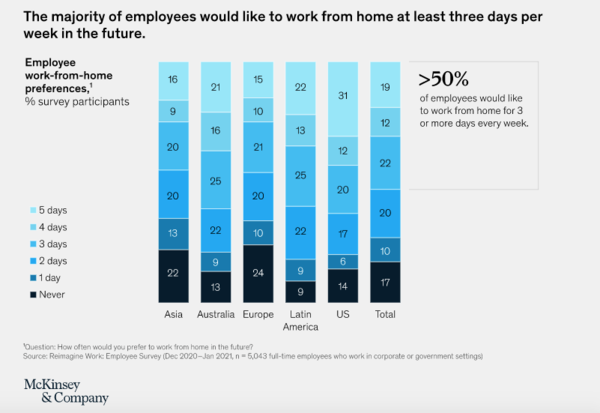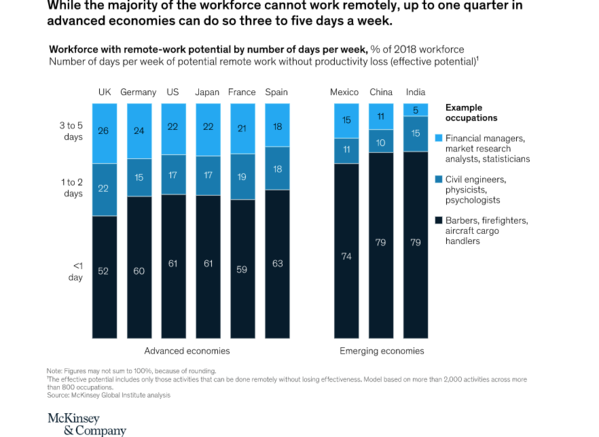The recently published article of McKinsey & Company “What employees are saying about the future of remote work” reports about the importance of preparing the post-pandemic organisation of work. Many surveys and articles have been written about whether the future of work will be an office work or telework or a combination of both and there is a general alignment towards a hybrid model of work in the future.
According to McKinsey, “organisations that have articulated more specific policies and approaches for the future workplace have seen employee well-being and productivity rise”. On the contrary, “at organisations that are communicating vaguely, or not at all, about the future of post-pandemic work, nearly half of employees say it’s causing them concern or anxiety. Anxiety is known to decrease work performance, reduce job satisfaction, and negatively affect interpersonal relationships with colleagues, among other ills. For the global economy, the loss of productivity because of poor mental health—including anxiety—might be as high as $1 trillion per year”.
Organisational limited information may also be due to the uncertainty deriving from remote work legislative changes or social partners’ agreements occurring in many countries (see here).
As a result of the survey conducted by McKinsey & Company between December 2020 and January 2021 among 5,043 full-time employees working for corporate or government settings, more than half reported that “they would like to work from home at least three days a week once the pandemic is over. Across geographies, US employees are the most interested in having access to remote work, with nearly a third saying they would like to work remotely full time”.

To thrive in this new reality and favour productivity increase, the surveyed employees presented their preferred working arrangements and related policies: “more than a third of respondents ranked clear hours and expectations for collaboration in their top five policies; several other collaboration policies, including technologies that enable on-site employees to dial-in to remote meetings and guidelines for documentation, also received significant support. Collaboration tools, and training for those tools, also rate highly for employees, as does reimbursement for remote-work office setups. Micro connectivity policies, meanwhile—from small team events to a listening and response strategy—were top policies for more than a quarter of all respondents”.
Concerning the number of employees who will be able to work in a hybrid model of office or remote work, another research from McKinsey & Company focussed on the question: “To what extent will remote work persist?”. To reply to this question, McKinsey analysed more than 2,000 activities in more than 800 occupations in China, France, Germany, India, Japan, Mexico, Spain, the United Kingdom, and the United States and identified which activities and occupations have the greatest potential for remote work. The analysis looked at the concrete tasks of each occupation and considered both the maximum potential (with all activities that can be performed remotely) and the effective potential (that excludes activities that can be theoretically performed remotely but are better performed in person, such as training for instance). The result is that “’finance and insurance’ has the highest potential, with three-quarters of time spent on activities that can be done remotely without a loss of productivity. Management, business services, and information technology have the next highest potential, all with more than half of employee time spent on activities that could effectively be done remotely”.

Considering tasks and occupations, the investigation concluded that “more than 20 percent of the workforce could work remotely three to five days a week as effectively as they could if working from an office”.
The dominant sectors of activities allow to define countries with more remote work potential than the others. In advanced economies “their workforces could dedicate 28 to 30 percent of the time to working remotely without losing productivity”. In emerging economies “the potential for time spent on remote work drops to 12 to 26 percent in the emerging economies we assessed”.
It continues “in the US workforce, we find that just 22 percent of employees can work remotely between three and five days a week without affecting productivity, while only 5 percent could do so in India. In contrast, 61 percent of the workforce in the United States can work no more than a few hours a week remotely or not at all. The remaining 17 percent of the workforce could work remotely partially, between one and three days per week”.
These profound changes “would have a profound impact on urban economies, transportation, and consumer spending, among other things”, including real estate costs.